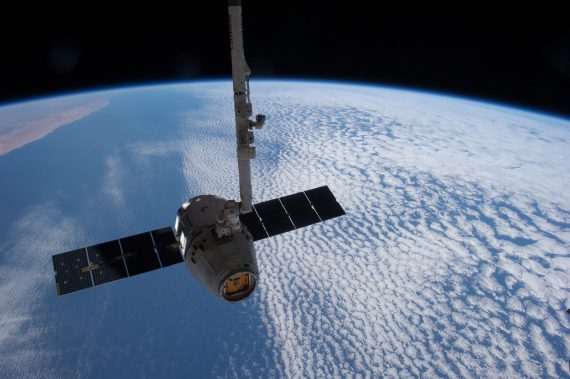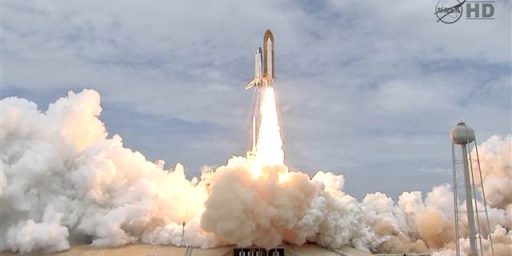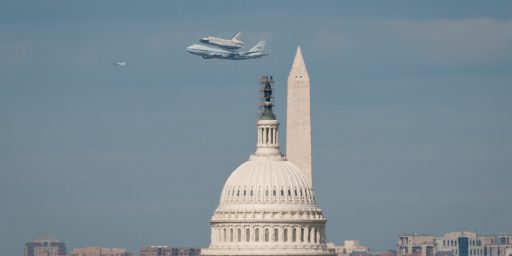The End Of Private Industry In Space? Hardly
A pair of accidents has led some to wonder if we are at the end of commercial ventures in space. Clearly, we are not.
The exlosion of an unmanned Orbital Sciences Antares rocket just seconds after launch last Tuesday, and Friday’s tragic loss of Virgin Galactic’s SpaceShipTwo over the Mojave Desert on Friday which left at least one pilot dead has led some to speculate what this might mean for commercial space ventures, which have been an important part of the American space program ever since the Shuttle program ended several years ago:
The crash of Virgin Galactic’s SpaceShipTwo experimental space plane on Friday, which killed one test pilot and severely injured another, may have wrecked the future of space tourism.
“For the industry, the joyride is over,” says attorney Michael Listner of the Space Law and Policy Solutions space law firm. “This is going to mean a lot more regulation. And there is the question of whether the industry will even survive.”
The Federal Aviation Administration announced Friday that it is investigating the crash, and Listner says the crash means the fledgling space tourism industry will now come under closer regulatory scrutiny.
U.S. commercial spaceflight is governed by a 2004 law giving the FAA oversight of the industry. Virgin Galactic’s main competitor in the promised space plane business is XCOR of Midlands, Texas, which has reportedly presold more than a hundred rides on its Lynx space plane for $95,000 apiece.
So far, the only real space tourists have purchased seven rides costing more than $20 million to the International Space Station aboard Russian rockets. All of them have traveled safely, although a 2007 test firing of rocket engines for SpaceShipTwo killed three engineers in an explosion.
“It will be interesting to see what happens to Virgin Galactic now, if passengers have second thoughts and start demanding refunds,” Listner says.
Jazz Shaw makes these observations:
[W]hat will kill off a private enterprise faster than anything else is a lack of a profitable market space. One of the things we’re learning from these explosive events is just how expensive a proposition all of this is. The Antares rocket cost in excess of 200 million and the price tag for SpaceShip Two was in the half billion range. These aren’t daunting numbers for large industrial players. Investments of that size or larger are made on a daily basis. But you do have to have a reasonable prospect of earning your money back.
The problem I’m wondering about here is that there are really only two target customer markets for these ventures. The government is the only viable buyer for services to ferry materials and astronauts to the space station. And while the government is a very regular customer, one change in administration or shift of a few decimal places in a budget committee report can dry up your sales overnight. The only other customers for an entity like Virgin Galactic are very high end, wealthy tourists. Initial ticket sales – even at a quarter million a seat – have been brisk, but one or two explosions can dampen the enthusiasm of your target audience. And even if everything had gone perfectly, there is surely a limit to the number of buyers for a service like this once the novelty has worn off.
As a preliminary matter, I think it’s important to differentiate between the various applications of commercial models to space. On the one hand, there is the idea of commercial space travel that is represented primarily, if not exclusively, by Sir Richard Branson’s Virgin Galactic. If that company ever did succeed, which at this point is quite obviously a very open question the answer to which has been put into doubt, it would operate very independently of government authorities outside of the same regulatory authority from the F.A.A. and N.T.S.B., and of course interactions with air traffic controllers and N.A.S.A. as far as flight operations would go. Personally, I’ve always been skeptical of the viability of that kind of business model in the short term. There’s only a limited number of people who can afford the $250,000 per flight that Virgin was proposing to charge passengers, and the flight itself doesn’t really last very long and doesn’t, say, reach a destination in orbit where you can stay for an extended period of time.
More importantly, even before Friday’s accident, one would imagine that the operating costs for something like Virgin Galactic were quite high. Development costs, of course, have been the biggest part of Virgin Galactic’s budget so far, of course. Assuming it ever became operational, though, the company would have to deal with everything from labor costs to fuel to all of the other costs a commercial airliner has to deal with. And then, of course, there would be the insurance. As far as I understand the laws at issue, a company like Virgin Galactic would not be covered by the international conventions that limit carrier liability in a crash so its potential costs in case of an accident when passengers were on board would likely have been astronomical even before Friday’s events. Indeed, it’s probable that the company would have to self-insure because it strikes me that there would be few insurers willing to sell coverage that would be the least bit affordable, especially after Friday. That’s one reason why I’ve generally considered Virgin Galactic to be little more than a Richard Branson vanity project that was unlikely to lead to a viable business in the near future.
Different from Virgin Galactic, though, is the side of commercial space travel represented by companies like SpaceX, Boeing, and Orbital Sciences. In these cases, we’re seeing what essentially amount to government contractors who are working with both N.A.S.A. and, to some extent, the military to deliver payloads to the International Space Station and into orbit. With the end of the Shuttle program, it has become an important part of the American space program, and for the most part has been quite successful. SpaceX has already delivered several payloads to the ISS, and is scheduled to send another one there in December. Orbital has also had mostly success as well, although the failure of the Antares on Tuesday will certainly be a setback for that company. Now, admittedly, each of these companies is hoping that, eventually the work they are doing for the government will lead to a commercial launch business that would having them contracting directly with private industry to launch things like communications satellites into orbit. Even in that case, though, there will still likely be coordination with government agencies and, likely, arrangements to lease the use of launch facilities for what would amount to a “private” launch.
Combined with the cargo delivery, of course, there are also ongoing efforts to develop the means to send personnel into orbit as well. Even here, though, the initial plans would involve contracting with the government to deliver astronauts to ISS and to create a means for returning Americans to Earth that doesn’t rely on the Russians and their Soyuz program. This side of the commercial business strikes me as something that is likely to have a very good chance of being commercial successful. Indeed, N.A.S.A. seems determined to ensure that it does succeed so that it can shift its attention to some extent away from launching satellites into orbit and toward things like more unmanned deep space probes, orbiting platforms to explore the universe, and taking the steps necessary to actually seriously talk about doing things like returning to the Moon and sending manned missions to Mars to do more than just collect some rocks and come back home. In that regard, its important to note that private industry has always had an important role to play in this part of the space program. The rockets N.A.S.A. uses have been generally privately developed and constructed for decades now. The Space Shuttle and its various components were completed by government contractors as well. Transitioning from that era to one where private companies play a greater role in the cargo delivery and satellite launching side of space travel isn’t really that radical of a change from the agency’s previous mission, and it certainly isn’t the kind of abandonment of space that many people accused the Obama Administration of undertaking when the Shuttle program, which was based on 40 year old technology by the time, was finally formally brought to an end.
For the time being, there’s obviously not going to be the kind of free market in space that some evangelists for commercial uses of space have talked about in the past. One imagines, for example, that Branson’s “space tourism” idea is pretty much dead for at least the next decade in much the same way the civilians in space program was put on hold after the Challenger disaster, but the involvement of private companies in the space program is likely to increase. Don’t be surprised, for example, to see things like SpaceX, Boeing, and other companies contracting directly with private companies for launches rather than going through the Federal Government. In other words, there is a future for the commercialization of space to some degree, but much of most of our efforts to “slip the surly bonds of Earth,” it is still at the point where we are moving slowly.
Photo of SpaceX Dragon docking with International Space Station via NASA







We are in an era like the early days of aviation when government airmail contracts nourished that industry, as far as sub-space traffic is concerned.
A personal soapbox: America can lose it’s lead in space by being foolish in terms of simple policy choices. Either greater effort to get into orbital and deep space which equals real money and not just at NASA but all the way through the science-supporting infrastructure we’ve so fortunately developed. If we lose the lead in space it will be as if we had no airlines and that the world was completely served by AirEmirates, a tremendous unforced error by the people who make budgets for the US.
The only thing that the US gov’t could have done better than awarding those airmail contracts was to have doubled or quadrupled them. But those were also days with a dominant conservative political slant (Harding, Coolidge).
The problem with space industry is that there is no China and no New World. Columbus didn’t cross the Atlantic “in the spirit of exploration”, contrary to popular myth. He did it because he wanted to make a killing in the China trade. Once he crossed, he discovered a whole New World of economic opportunity.
In space, we don’t see a China (potential business opportunity) or New World ( actual business opportunity) other than satellites. Now if unobtainium was discovered on Mars, then we would have the kind of business opportunity that would get us into space in a big way, but other than something like that, its hard to see a big move into space industry for the foreseeable future. I’m not happy about that, but that’s how I see it.
I think the best chance may be a big drive by governments for renewable energy, because burning fossil fuels drives ruinous climate change. Then solar power satellites become a business possibility, and with it Moon mines, space colonies, asteroid mining, etc. as sketched out by Gerald O’Neill, etc.
Oddly enough, some of the people most opposed to doing anything about climate change seem to be the biggest space industry boosters. Oh well, we’ll see what happens.
I’m trying to imagine the liabilities in blowing up very wealthy tourists: insurance costs will be exraordinary.
With the exception of taking rich tourists into space, something the Russians have been doing for years, I don’t see how things have really changed that much. Although they were involved NASA never designed or built their own spacecraft. Today NASA is still heavily involved in the “civilian” space business.
I think there is a future market in civilian space travel, but it will be a long time coming. For a long time, there wasn’t a market in civilian air travel either. Hell, for a long time civilian *ocean* travel was only for the rich, the subsidized or the get-the-hell-out-of-our-country. In both cases, they were incredibly dangerous. But in both case, they are now routine.
What we really need is a technological breakthrough that makes orbit much much cheaper. That might be better rockets. It might be magnetic catapults. It might be space elevators. It might be none of the above. I see Virgin Galactic and SpaceX as pathfinders, providing one of the many ways to try to figure this out. If either or both fail, someone else will come through. Because as long as human beings need living space, energy and rare elements, space will retain a commercial potential.
@stonetools: Helium-3 on the Moon?
Actually, sitting at the top of a gravity well ain’t such a bad idea if you need to get from Point A to Point B.
A mechanism for getting into space that didn’t involve sitting on top of a lot of explosive (a.k.a. Space Elevator) would restart the whole Space Tourism thing in a jiffy. Diamond threads look to be the next candidate material. (Nanotubes are too stretchy, boing-boing.)